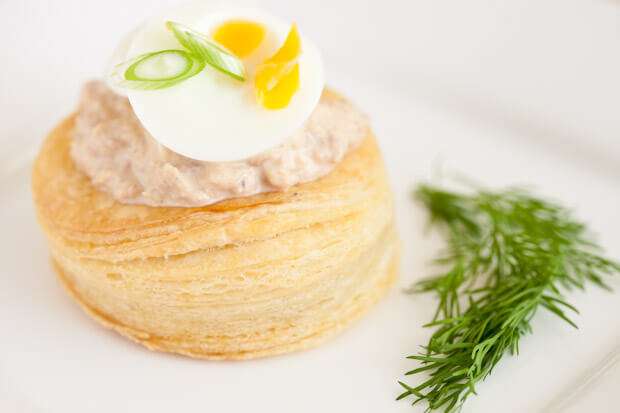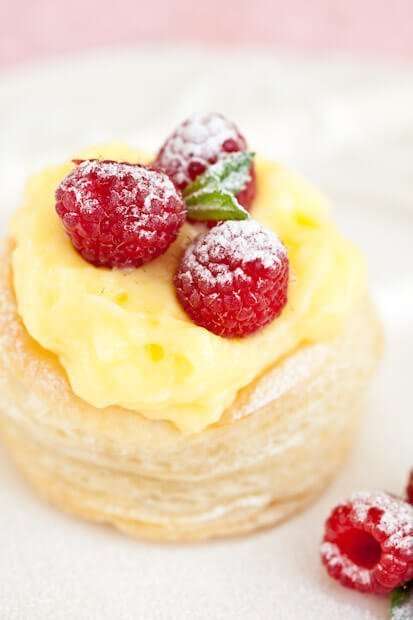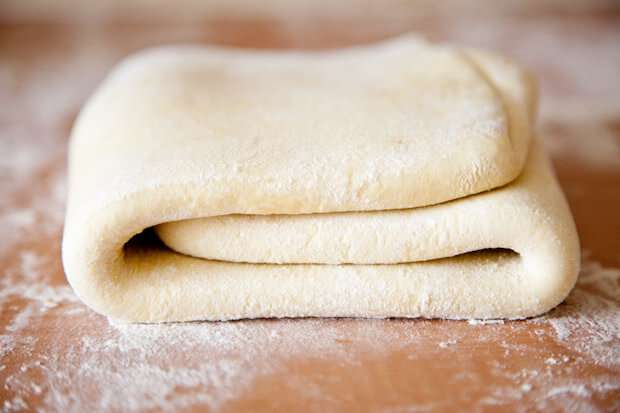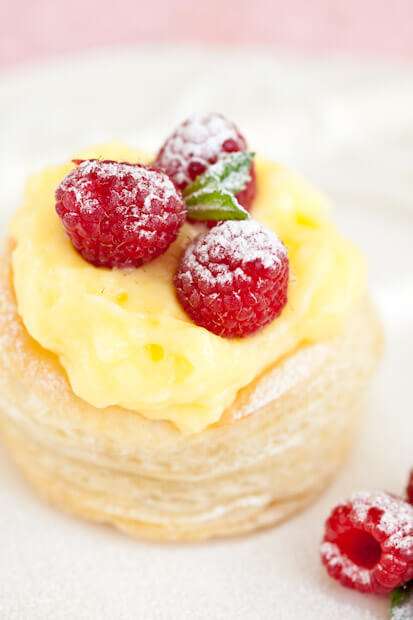Vol-au-vents: Daring Bakers september 09

When coming back from holiday one of the first things I did was to check out the new assignment for the daring bakers. I would ofcourse have less time then the usual month, so figured I should make sure that I could do it in the time left. So when I read that we were to make puff pastry my first reactions was ‘o nooooo’ thinking that it would be really hard to make!
And I am not going to tell you here that it was incredibly easy or that nothing can go wrong, but it was a rather pleasant surprise to find that it is nowhere near as difficult as some people might make you believe. Ok, mine weren’t perfect as they didn’t rise evenly (even with or without using the silicon mat to weigh it down in the beginning) but I am guessing I did something wrong somewhere. The taste sure wasn’t any less for it!

The September 2009 Daring Bakers’ challenge was hosted by Steph of A Whisk and a Spoon. She chose the French treat, Vols-au-Vent based on the Puff Pastry recipe by Michel Richard from the cookbook Baking With Julia by Dorie Greenspan.
The whole process starts with adding flour and water to make the dough and then add a pound of unsalted butter into the dough (process is explained in the recipe). I was glad that I watched a couple of videos on how the process was supposed to look, as without it I would have been even more afraid to start with making my first ever puff pastry.
After spending quite some time making the dough, doing all the turns, chilling the dough in between, etc. I didn’t really feel like coming up with something elaborate on the filling so I chose some very basic stuff. The savoury one was filled with home made tuna salad (with canned tuna I still had in the cupboard) and the sweet one was made with bakers cream and raspberries. I will be making a few more with whipped cream and strawberries also but no photos of those.
I’ve only used 1/3 of the dough so will probably be making more out of them. We’re going to have various filling tonight for dinner, so depending on how many are being devoured I will probably still freeze something too.
After all the anticipation I had it was easier then I thought and I might even attempt to make this again! You hardly need any ingredients at all, apart from the filling and the dough is quite versatile. You can make vol-au-vents but you can use for lots of different pastry thingies as well. I’ve got to think of what to make with the remaining dough. While I like vol-au-vents; I don’t want to use all the dough for that.
The instructions for making them is quite lengthy but here it is!
Forming and Baking the Vols-au-Vent
Yield: 1/3 of the puff pastry recipe below will yield about 8-10 1.5” vols-au-vent or 4 4” vols-au-vent
In addition to the equipment listed above, you will need:
-well-chilled puff pastry dough (recipe below)
-egg wash (1 egg or yolk beaten with a small amount of water)
-your filling of choice
Line a baking sheet with parchment and set aside.
Using a knife or metal bench scraper, divided your chilled puff pastry dough into three equal pieces. Work with one piece of the dough, and leave the rest wrapped and chilled. (If you are looking to make more vols-au-vent than the yield stated above, you can roll and cut the remaining two pieces of dough as well…if not, then leave refrigerated for the time being or prepare it for longer-term freezer storage. See the “Tips” section below for more storage info.)
On a lightly floured surface, roll the piece of dough into a rectangle about 1/8 to 1/4-inch (3-6 mm) thick. Transfer it to the baking sheet and refrigerate for about 10 minutes before proceeding with the cutting.
(This assumes you will be using round cutters, but if you do not have them, it is possible to cut square vols-au-vents using a sharp chef’s knife.) For smaller, hors d’oeuvre sized vols-au-vent, use a 1.5” round cutter to cut out 8-10 circles. For larger sized vols-au-vent, fit for a main course or dessert, use a 4” cutter to cut out about 4 circles. Make clean, sharp cuts and try not to twist your cutters back and forth or drag your knife through the dough. Half of these rounds will be for the bases, and the other half will be for the sides. (Save any scrap by stacking—not wadding up—the pieces…they can be re-rolled and used if you need extra dough. If you do need to re-roll scrap to get enough disks, be sure to use any rounds cut from it for the bases, not the ring-shaped sides.)

Using a ¾-inch cutter for small vols-au-vent, or a 2- to 2.5-inch round cutter for large, cut centers from half of the rounds to make rings. These rings will become the sides of the vols-au-vent, while the solid disks will be the bottoms. You can either save the center cut-outs to bake off as little “caps” for you vols-au-vent, or put them in the scrap pile.
Dock the solid bottom rounds with a fork (prick them lightly, making sure not to go all the way through the pastry) and lightly brush them with egg wash. Place the rings directly on top of the bottom rounds and very lightly press them to adhere. Brush the top rings lightly with egg wash, trying not to drip any down the sides (which may inhibit rise). If you are using the little “caps,” dock and egg wash them as well.
Refrigerate the assembled vols-au-vent on the lined baking sheet while you pre-heat the oven to 400ºF (200ºC). (You could also cover and refrigerate them for a few hours at this point.)
Once the oven is heated, remove the sheet from the refrigerator and place a silicon baking mat (preferred because of its weight) or another sheet of parchment over top of the shells. This will help them rise evenly. Bake the shells until they have risen and begin to brown, about 10-15 minutes depending on their size. Reduce the oven temperature to 350ºF (180ºC), and remove the silicon mat or parchment sheet from the top of the vols-au-vent. If the centers have risen up inside the vols-au-vent, you can gently press them down. Continue baking (with no sheet on top) until the layers are golden, about 15-20 minutes more. (If you are baking the center “caps” they will likely be finished well ahead of the shells, so keep an eye on them and remove them from the oven when browned.)
Remove to a rack to cool. Cool to room temperature for cold fillings or to warm for hot fillings.
Fill and serve.
*For additional rise on the larger-sized vols-au-vents, you can stack one or two additional ring layers on top of each other (using egg wash to “glue”). This will give higher sides to larger vols-au-vents, but is not advisable for the smaller ones, whose bases may not be large enough to support the extra weight.
*Although they are at their best filled and eaten soon after baking, baked vols-au-vent shells can be stored airtight for a day.
*Shaped, unbaked vols-au-vent can be wrapped and frozen for up to a month (bake from frozen, egg-washing them first).

Michel Richard’s Puff Pastry Dough
Ingredients
- 2-1/2 cups 12.2 oz/ 354 g unbleached all-purpose flour
- 1-1/4 cups 5.0 oz/ 142 g cake flour
- 1 tbsp. salt you can cut this by half for a less salty dough or for sweet preparations
- 1-1/4 cups 10 fl oz/ 300 ml ice water
- 1 pound 16 oz/ 454 g very cold unsalted butter
- plus extra flour for dusting work surface
Mixing the Dough:
- Check the capacity of your food processor before you start. If it cannot hold the full quantity of ingredients, make the dough into two batches and combine them.
- Put the all-purpose flour, cake flour, and salt in the work bowl of a food processor fitted with a metal blade and pulse a couple of times just to mix. Add the water all at once, pulsing until the dough forms a ball on the blade. The dough will be very moist and pliable and will hold together when squeezed between your fingers. (Actually, it will feel like Play-Doh.)
- Remove the dough from the machine, form it into a ball, with a small sharp knife, slash the top in a tic-tac-toe pattern. Wrap the dough in a damp towel and refrigerate for about 5 minutes.
- Meanwhile, place the butter between 2 sheets of plastic wrap and beat it with a rolling pin until it flattens into a square that’s about 1″ thick. Take care that the butter remains cool and firm: if it has softened or become oily, chill it before continuing.
Incorporating the Butter:
- Unwrap the dough and place it on a work surface dusted with all-purpose flour (A cool piece of marble is the ideal surface for puff pastry) with your rolling pin (preferably a French rolling pin without handles), press on the dough to flatten it and then roll it into a 10″ square. Keep the top and bottom of the dough well floured to prevent sticking and lift the dough and move it around frequently. Starting from the center of the square, roll out over each corner to create a thick center pad with “ears,” or flaps.
- Place the cold butter in the middle of the dough and fold the ears over the butter, stretching them as needed so that they overlap slightly and encase the butter completely. (If you have to stretch the dough, stretch it from all over; don’t just pull the ends) you should now have a package that is 8″ square.
- To make great puff pastry, it is important to keep the dough cold at all times. There are specified times for chilling the dough, but if your room is warm, or you work slowly, or you find that for no particular reason the butter starts to ooze out of the pastry, cover the dough with plastic wrap and refrigerate it . You can stop at any point in the process and continue at your convenience or when the dough is properly chilled.
Making the Turns:
- Gently but firmly press the rolling pin against the top and bottom edges of the square (this will help keep it square). Then, keeping the work surface and the top of the dough well floured to prevent sticking, roll the dough into a rectangle that is three times as long as the square you started with, about 24″ (don’t worry about the width of the rectangle: if you get the 24″, everything else will work itself out.) With this first roll, it is particularly important that the butter be rolled evenly along the length and width of the rectangle; check when you start rolling that the butter is moving along well, and roll a bit harder or more evenly, if necessary, to get a smooth, even dough-butter sandwich (use your arm-strength!).
- With a pastry brush, brush off the excess flour from the top of the dough, and fold the rectangle up from the bottom and down from the top in thirds, like a business letter, brushing off the excess flour. You have completed one turn.
- Rotate the dough so that the closed fold is to your left, like the spine of a book. Repeat the rolling and folding process, rolling the dough to a length of 24″ and then folding it in thirds. This is the second turn.
Chilling the Dough:
- If the dough is still cool and no butter is oozing out, you can give the dough another two turns now. If the condition of the dough is iffy, wrap it in plastic wrap and refrigerate it for at least 30 minutes. Each time you refrigerate the dough, mark the number of turns you’ve completed by indenting the dough with your fingertips. It is best to refrigerate the dough for 30 to 60 minutes between each set of two turns.
- The total number of turns needed is six. If you prefer, you can give the dough just four turns now, chill it overnight, and do the last two turns the next day. Puff pastry is extremely flexible in this regard. However, no matter how you arrange your schedule, you should plan to chill the dough for at least an hour before cutting or shaping it.
Disclaimer
The nutritional values above are calculated per portion. The details are based on standard nutritional tables and do not constitute a professional nutritional advice.


Gorgeous Simone! The tuna one brings back a lot of memories! Maybe you could make a tart with the remaining dough and fill it with mascarpone, vanilla and fresh berries and dusted with icing sugar! A great effort overall!
That looks wonderful. Well done.Your pics are lovely I love making pastry and I haven’t made puff pastyr for a long time. I think I’ll copy this recipe and try it.
Looks beautiful. Loved your choice of fillings. Great job!
Beautiful photos as always!
I was also pleasantly surprised that making puff pastry isn’t actually as hard as it seems 🙂
Great baking 🙂
It seems like we all tried our sweet and savory versions. Looks wonderful Simone!
Beautiful photos and that tuna one sounds absolutely moreish.
Beautiful photos and that tuna one sounds absolutely moreish.
Beautiful photos! they look incredible! Just gorgeous, love the sweet version! yumm
Beautiful photos! they look incredible! Just gorgeous, love the sweet version! yumm
Absolutely beautiful!
well done. It’s very beautiful!
Yours look lovely…stunning
Beautiful! I love your choice of fillings! Great job!
Cheers,
Rosa
Your vol au vents look amazing and what beautiful photography! 😀
Gorgeous as always: Love the last photo.
I have some of the dough sitting in my freezer…so will have to give it another try.
Great pictures! Your Vol-au-vents look delicious.
Amazingly beautiful and lovely pictures too. I love everything about it.
Gorgeous! Beautiful photos, and I love the rise you got =D.
Both your vol-au-vents look beautiful. The pastry cream with the raspberries sounds divine. Its always nice when things work out easier than expected
Your pastry looks great! Mine was a failure:( I love your yummy filling too:)
Beautiful photos, and great choice of fillings too. Nice work!
You’ve just made me less afraid of making puff pastry! One of these days I’ll attempt it.
BEAUTIFUL dessert!
This was my first challenge and I just loved it. Your pastry came out beautifully!
great job. can’t wait to see what you do with the leftover dough.
You did a great job! There are so many tiny little things that can possibly go wrong and make them uneven but really you can’t tell from the pictures.
Loved your dessert version, looks so inviting.
A feast for the eyes Simone…gorgeous stuff here. Love both the flavour combinations & love how well your pastry rose! I might as well add that I’m hopelessly distracted by the Italian mousse below…YUM!
The photos of your pastry in progress, and the finished product, are beautiful! The raspberries and cream are my favorite…YUM!
Wow I can’t believe i’ve never come across your blog before its so nice! Well done on this month’s challenge too! 🙂
very very pretty!
very very pretty!
Simone, my photos are great? HA! Thank you for the compliment, as it means so much coming from an amazing photographer!! I’d die to have your eye and talent!
On that note, your layers are gorgeous, and I’m inlove the the raspberries with pastry cream! YUM!
what a lovely choice of fillings simone. just fantastic. i am really loving this vol-au-vent party!
LOVE the process photos. Great job!
Love your V-a-Vs!!! The photos looks amazing, and I’m sure they taste even better! 🙂
As usual, you did a wonderful job!! I am so excited to try this soon.
I love that pic of the folded dough. So beautiful!
Gorgeous! Your photos are simply dreamy, I feel as if I could almost puck a raspberry right out of the screen! Stunning pastry, of course.
Beautiful work! I would totally make these again — isn’t that a fun realization?? That a recipe is not only doable … but do-againable! 😀
Love your vol-au-vents!
First of all, your vols-au-vents look amazing. I love anything with puff pastry (who doesn’t), both sweet and savoury. Secondly, thank you so much for introducing us to that video. Richard makes it look so easy and effortless, I might actually try it soon and make a whole lot of pastry goodies!
You should really try it Jo! It is actually much easier then I had thought it would be. It requires time but once you’ve got the butter thing going it’s really not that hard and I am sure you would be great at it!
Beautiful pictures! Both the sweet and savory pastries look delicious! Great job! 🙂
Absolutely beautiful! I think the uneven rise gives your vols au vent a certain kind of charm. They look so lovely and flaky!